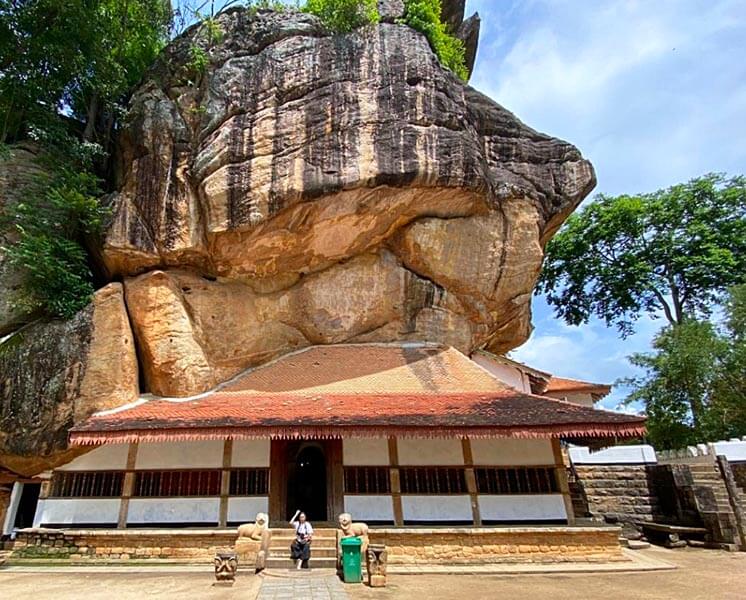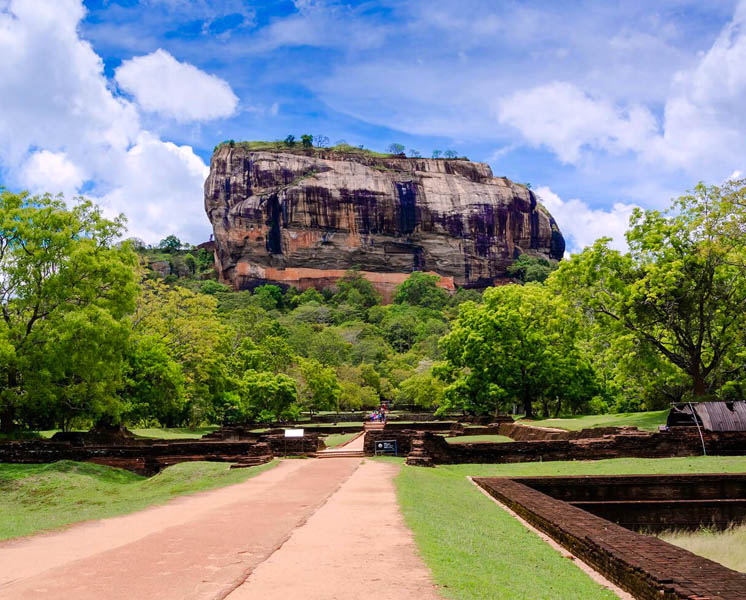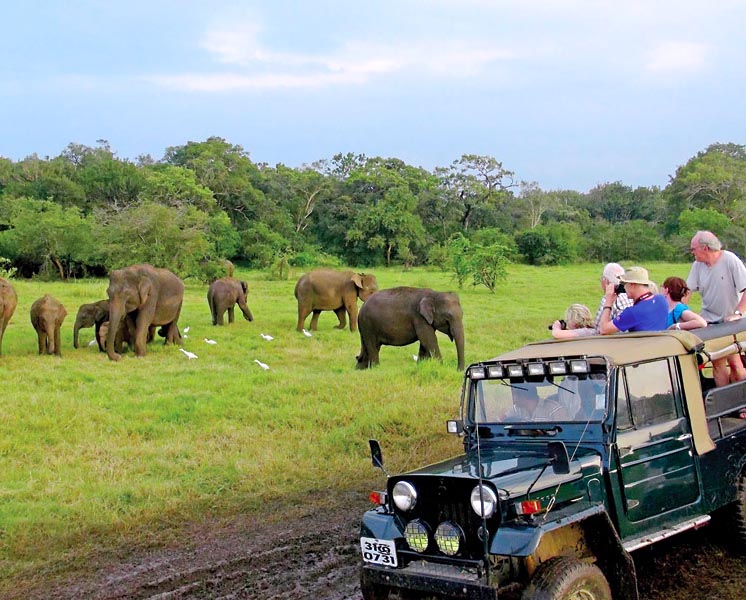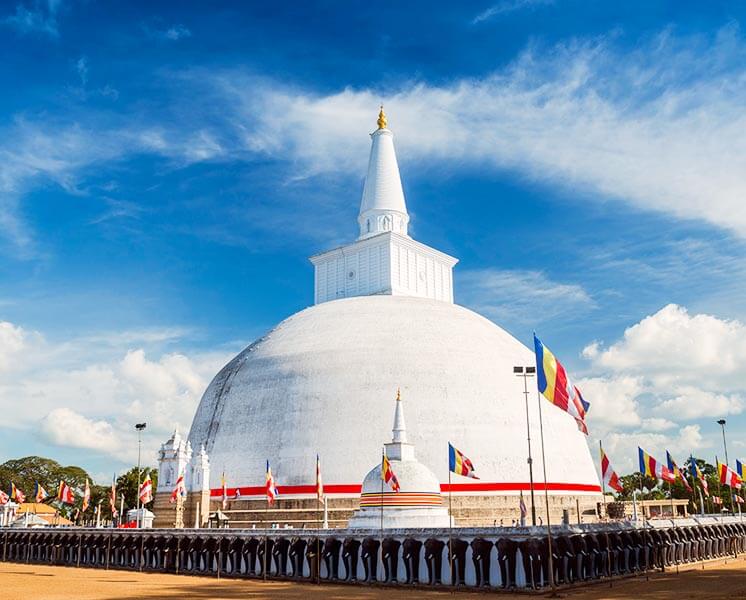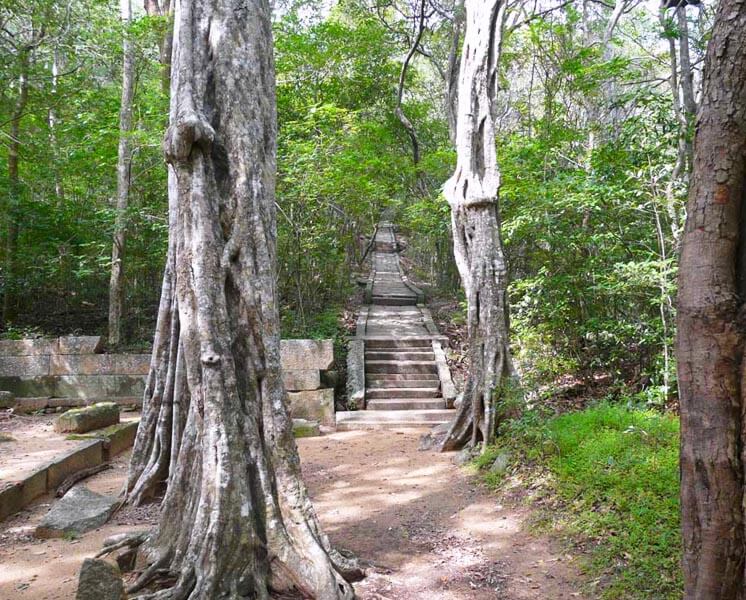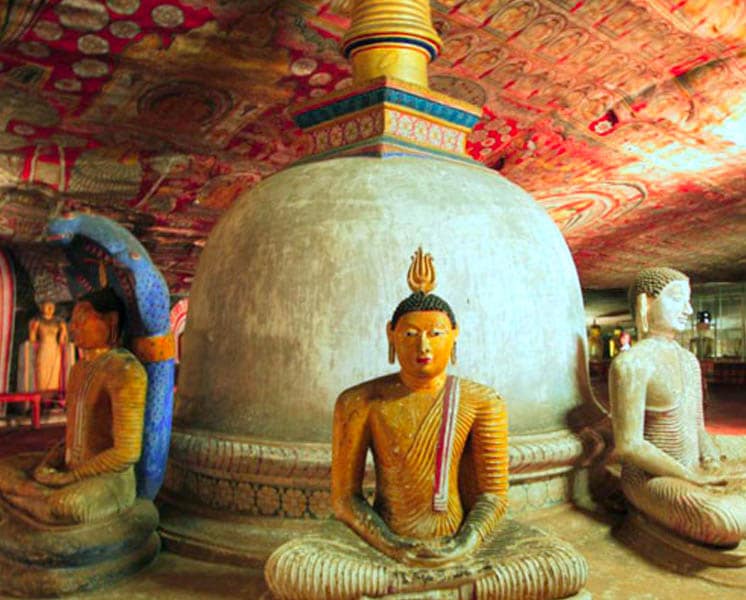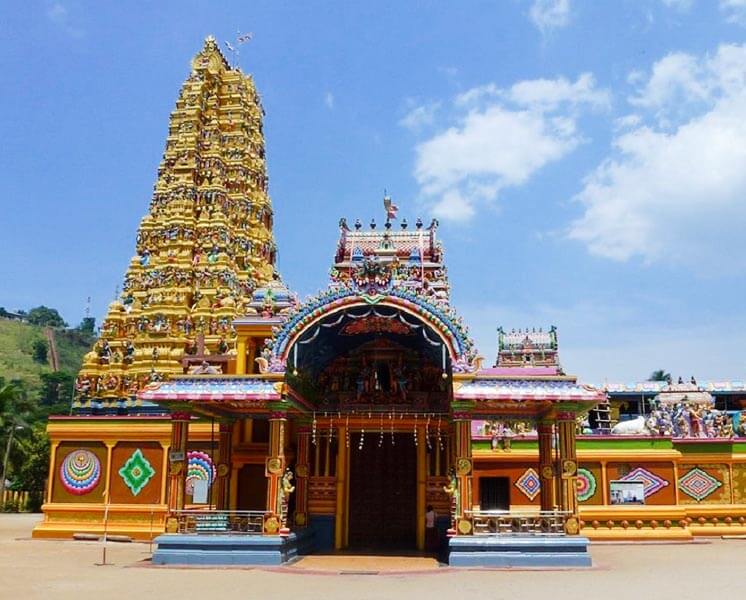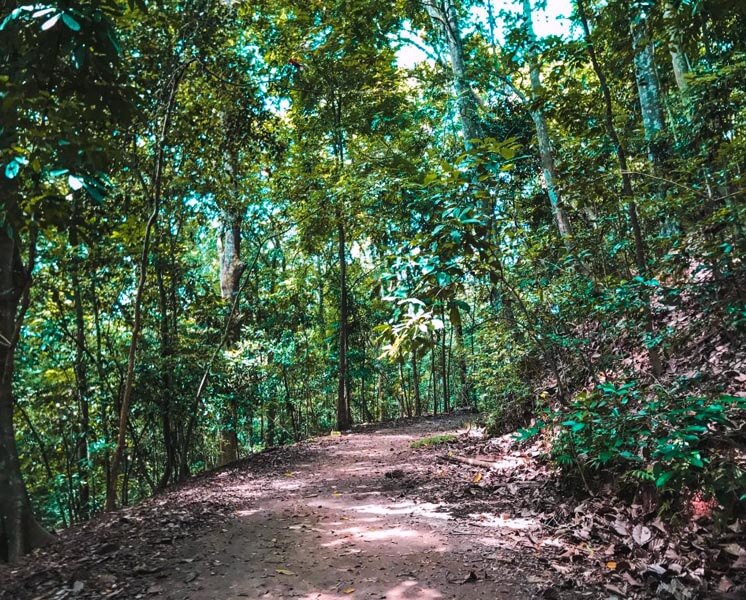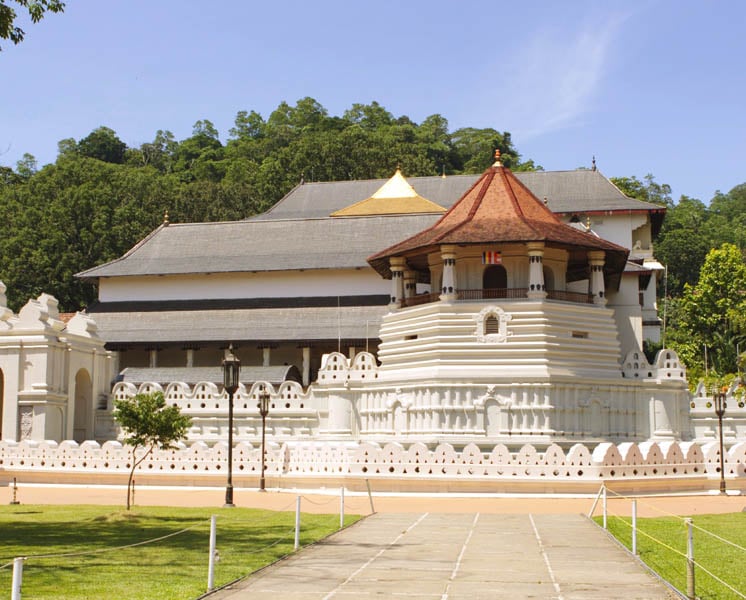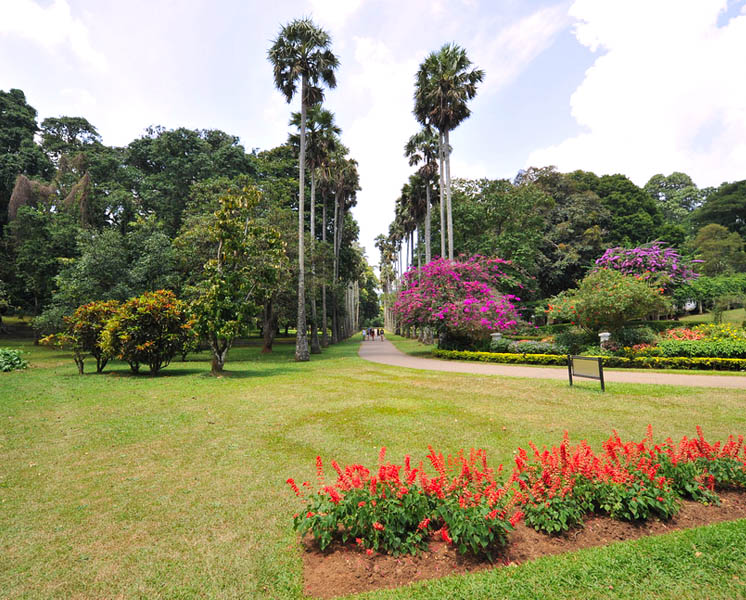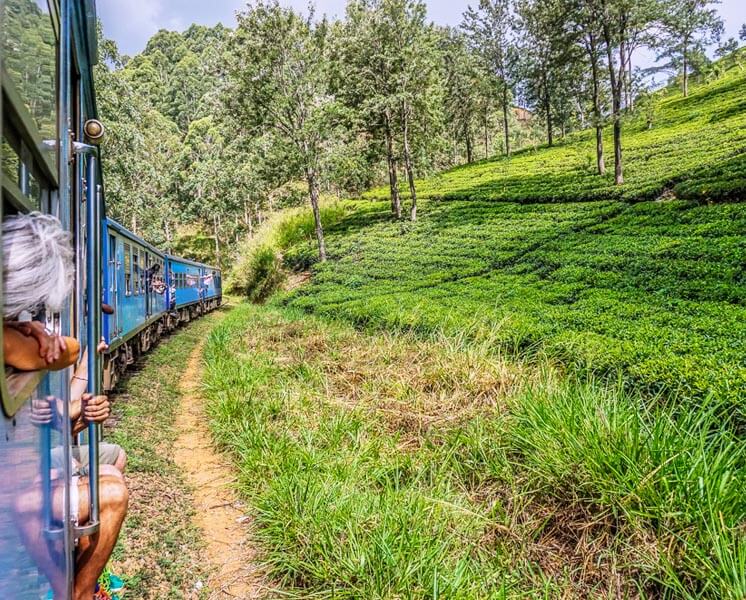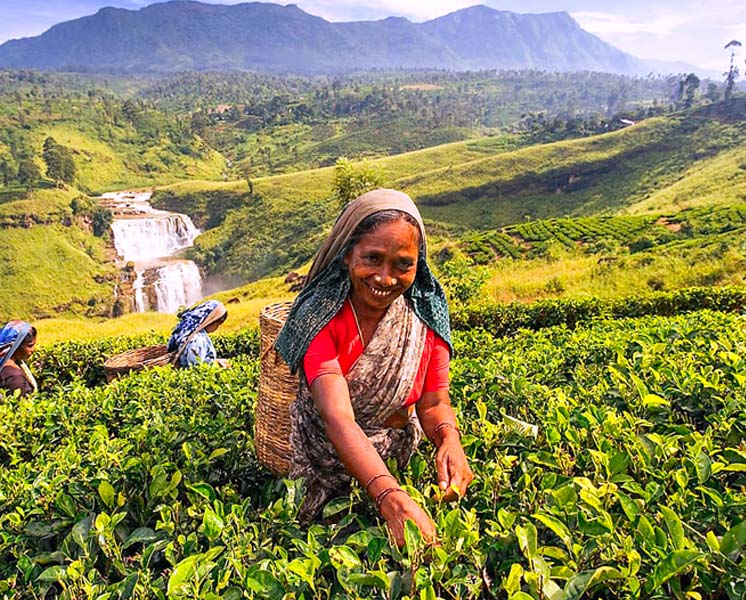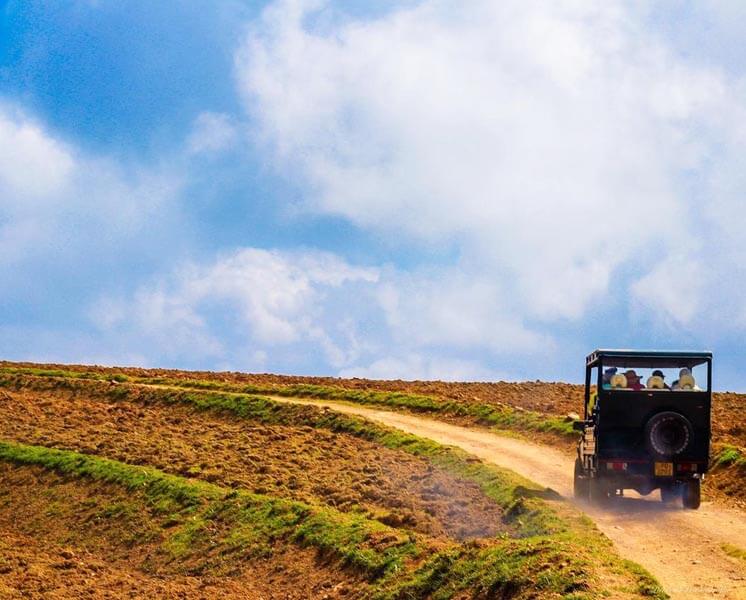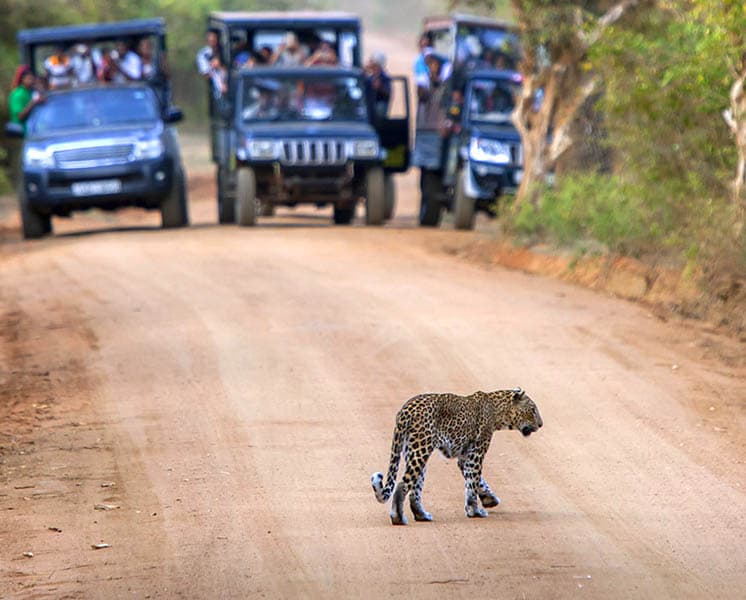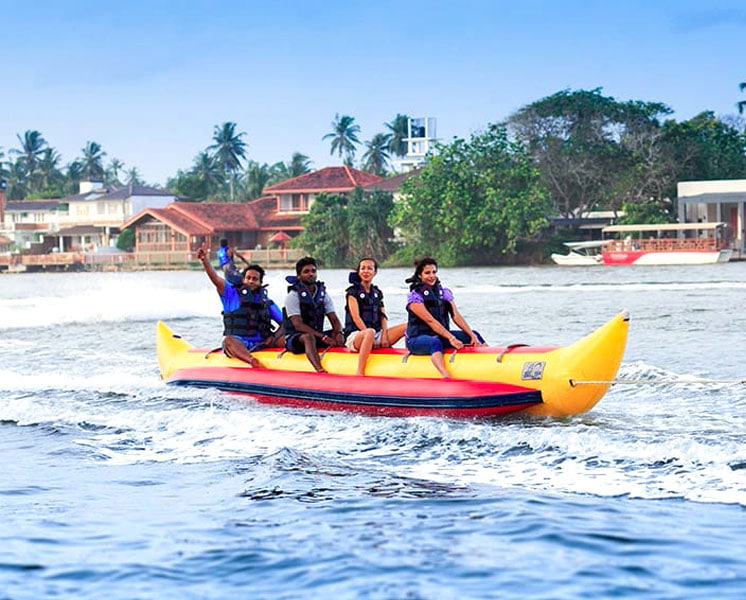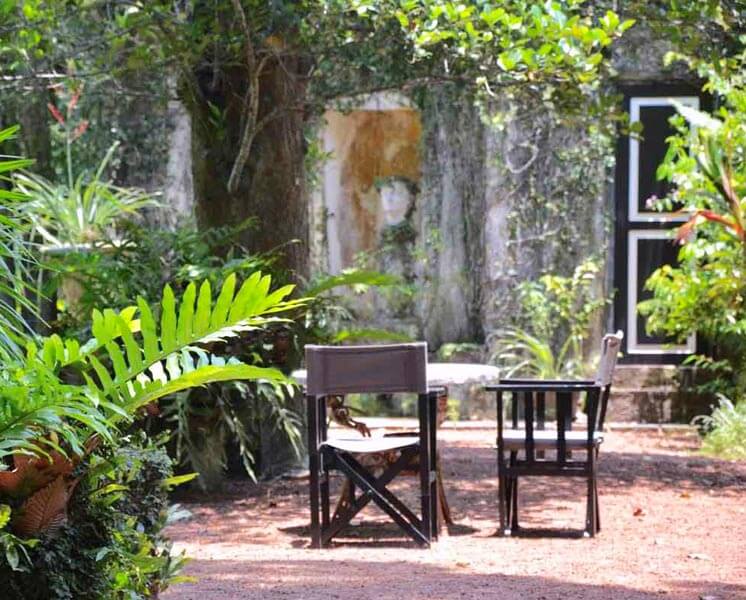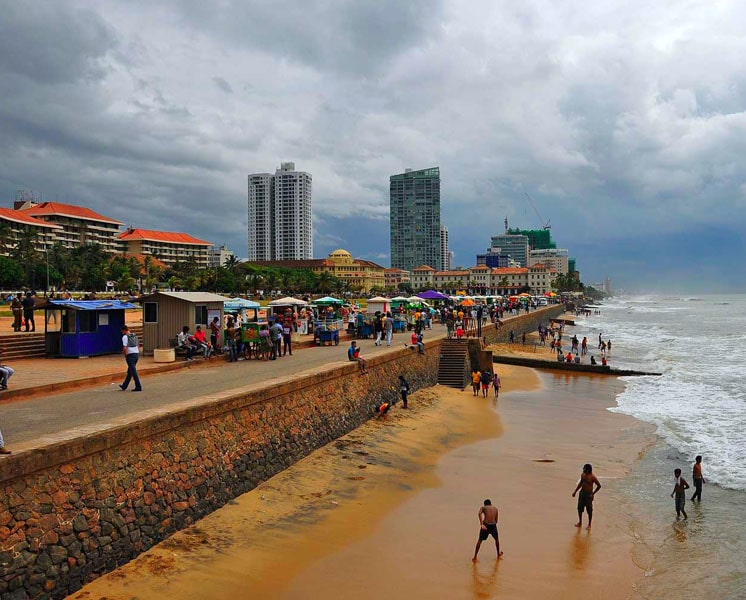Itinerary of
14 Days 13 Nights Tour
DAY 01 : Airport / Negombo
Picking up from the Airport and dropping to the Negombo Hotel.
DAY 02 : Negombo / Dambulla
Visiting & Activities: On the way to Dambulla visit Ridi Viharaya / Elephant Ride
Ridi Viharaya or the Silver Temple was built at the place where Silver ore was found, that was made used to build Ruwanweli Dageba at Anuradhapura by King Dutugemunu during his reign. To reach the Ridi Vihara, proceed along Kandy- Kurunegala highway turn off at Mallawapitiya and proceed to Ridigama for about 13 kM. Then proceed about 2 kM to find Ridi Vihara which is built under a rock outcrop which stands about 200 feet high from the surrounding area.
Ridi Vihara is an important Raja Maha Vihara belonging to the Cultural Triangle. Historical Data on this Monastery complex is found in some Caves written in Brahmin Inscriptions. They dates back to the 2nd and 3rd Centuries BC. During the time of Arahath Mahinda, many Arahaths are believed to be resided in these caves which numbers around twenty five in the surrounding area of Ridi Vihara and Rambadagalla area. The caves had been prepared by cutting into the rock and donated by chieftains of the area to the Sangha.
Elephant Ride: Habarana, located 210km north east from Colombo is the transit point for the large herds of wild elephants at the National Parks of Minneriya and Kaudulla. Habarana is a popular location among the wildlife enthusiasts and nature tourists. Moreover, Habarana being the central location of the cultural triangle of Sri Lanka, attracts many culture tourists. The irrigation reservoirs and waterways of the area bring in a riverine terrain where the elephants would wade through, or swim to reach the banks in the further end. The ride would take you over the main road, the pathways, villages, jungles, swamp and river. The best period for Elephant Back Safaris at Habarana is during March to July when the water level of the river is high enough to ride the elephant. From August to November the level of water in the river is low. During December to February when it’s the rainy season at Habarana, the river would flow.
DAY 03 : Dambulla
Visiting& Activities: Sigiriya Fortress Rock climb / Village Tour with the Local Lunch / Minneriya National Park Elephant Safari
Sigiriya or Sinhagiri (Lion Rock) is an ancient rock fortress located in the northern Matale District near the town of Dambulla in the Central Province, Sri Lanka. The name refers to a site of historical and archaeological significance that is dominated by a massive column of rock nearly 200 metres (660 ft) high. According to the ancient Sri Lankan chronicle the Culavamsa, this site was selected by King Kasyapa (477 – 495 CE) for his new capital. He built his palace on the top of this rock and decorated its sides with colourful frescoes. On a small plateau about halfway up the side of this rock he built a gateway in the form of an enormous lion. The name of this place is derived from this structure —Sīhāgiri, the Lion Rock. The capital and the royal palace was abandoned after the king’s death. It was used as a Buddhist monastery until the 14th century. 1700 Steps. Overall Visit hours : 2-3hrs.
Village Tour Activity at Dambulla included Bullock Cart Ride / Barge Ride / Village House Local Cooking demonstration and activities / Tropical SL Traditional Lunch with the Village People/Back to the starting point by a Tuk Tuk.
Minneriya National Park gives the opportunity to see herds of Elephants throughout the year. May to October is the best period to visit Minneriya National Park in view of the famous Gathering of the wild elephants. It is the largest known meeting place of Asian Elephants in the world. During this period herds up to 300 elephants are seen at the 8,890-hectare park within a few square kilometers of the Minneriya Reservoir. In August and September each year during the dry season, wild elephants from the surrounding wilderness in search of food and water, makes their way to the shores of the Minneriya Reservoir adjoining the Minneriya National Park. Huge herd of elephants, sometimes numbering up to 300, converge together within a few square kilometers of the lake.
DAY 04 : Dambulla
Visiting & Activities: Anuradhapura Historical City / Ritigala Monastery Hike
The ruins of Anuradhapura are one of South Asia’s most evocative sights. The sprawling complex contains a rich collection of archaeological and architectural wonders: enormous dagobas (brick stupas), ancient pools and crumbling temples, built during Anuradhapura’s thousand years of rule over Sri Lanka. Today, several of the sites remain in use as holy places and temples; frequent ceremonies give Anuradhapura a vibrancy that’s a sharp contrast to the museum-like ambience at Polonnaruwa.
Visiting Spots in Anuradhapura:
Anuradhapura Ruins, MahamevnawaDhammachethiya Buddhist Monastery/ Jetavanarama monastery, RatnaPrasada/Jewel palace and guard stone, Abhayagiri Dagaba/Vihara/Monastery Complex and Moonstone, Samadhi Buddha Statue, KuttamPokuna(Twin Ponds), Gal Palama (Stone Bridge), Thuparamaya, RuwanwelisayaSthupa, Brazen Palace, Jaya Sri Maha Bodhi, Sri Maha Bodhi Mawatha, RanmasuUyana, Isurumuniya RajamahaViharaya, The Royal Botanical Gardens, Mihintale peak, Mihintale Archaeological Museum
Ritigala Mountain at a height of 766 m above the sea-level is the highest mountain in the north-central dry plains of Sri Lanka. The mountain mass about three miles long and about two miles wide at its widest point is covered with dense jungle inhabited by wild elephants, leopards and bears. It is the watershed of the MalwatuOya which feeds the Nachaduwa tank and Kalueba Ela which feeds Huruluwewa. TheRitigala Mountain has been declared a Strict Natural Reserve in order to maintain its pristine environment. Ritigala mountain’s cloud cover and mist that cloth it most of the year round has resulted in a flora much more commonly found at the central hills of wet zone than those in the dry plains: the upper part of the mountain is well known for its flora, some of which are rare; it has also a range of wild orchids.
DAY 05 : Dambulla / Kandy
Visiting & Activities: Dambulla Cave Temple UNESCO Heritage Site/ Visit Spice Garden “Ranveli” in Matale District / Matale Sri Muthumaari Amman Hindu Temple / Galmaduwa Temple
The Rock Cave Temple of Dambulla, called Jumbukola Vihara (Dambulla Cave Temple) in the (Mahavamsa)-the principal Pali Chronicle of Sri Lanka, is situated about forty seven miles north west of Kandy, the last capital of the Sinhalese kings, on the main road to Anuradhupura.
There are five caves (shrine rooms) in Dambulla temple. All of these caves arc full of statues of Buddha and various personages of the Buddhist Order or History. There are 150 Buddha images in these caves. Cave No. 5 (the last in order) has no historical value as it was done in the second decade of this century. All of the other caves contain statues and paintings representing various epochs of Sinhalese sculpture and painting. The early paintings of Dambulla are believed by some to belong to the 8th century A. C. But this cannot be proved at all because of over painting. Nevertheless, this place is a mine of decorative designs, the patterns of which resemble those of Sigiriya. To a student of the history of Buddhism a careful study of the paintings of Dambulla provides a good deal of source material.
Sri Muthumaari Amman Hindu Temple: Just north of the bus stand for Kandy (at the north end of town) is this interesting South Indian–style Hindu temple. A couple of garages to the side house five enormous, colourful ceremonial chariots pulled along by people during the annual Theru festival in February/March.
Galmaduwa Temple: A short turn off from the Kundasala Road just outside of Kandy and you will come upon a strange sight: the unfinished Galmaduwa Viharaya. Traditionally ascribed to King Keerthi Sri Rajasinghe, it is said that while this building was being completed the king heard of the discovery of a cave at Degaldoruwa and stopped the work on Galmaduwa shifting his attention to Degaldoruwa. Sadly, in its unfinished state, this building was never used as a temple. The Galmaduwa viharaya is an impressive building of strange architecture. As its local name suggests, it is basically a pavilion built of stone and brick. But a high gopuram gives it a Hindu identity. There is an ad mixture of Tamil-Hindu influence within the Buddhist place of worship.
DAY 06 : Kandy
Visiting & Activities: UdawattaKele Sanctuary Hike / Royal Botanical Garden / Visit World Famous Blue Sapphire Gem Museums / Bahirawakanda Temple / Traditional Cultural Kandyan Dance with Firewalk / Tooth Relic Temple / Kandy View Point (if we have time we can do Ceylon Tea Museum , Wales Park & Pallekelle International Cricket Stadium)
Udawattakale Sanctuary: The forest is rich with vegetation consisting with canopy, sub canopy and an underground layer. The dense plant life restricts sunlight reaching the ground soil surface. The underground layer mostly consists of the seedlings of the canopy layer species and creepers that reaches to the top of caopy layer trees. There is a giant 200 to 300 years old “Pus Wela” or ‘Entada pusaetha’ liana in the forest. The important places in UdawattaKele are the The water Pond, Highest peak “Kodimale”, The Senkanda Cave, and the Garrison cemetery. There are also several Buddhist temples and hermitages inside the forest reserve. Some of the Tree species found in the forest are ‘Acronychia pedunculata’ (Ankenda) ,Adenantherapavonina (Madatiya), Aleurites moluccana (Tel kekuna), Antidesmabunius (KarawalaKebella).
Temple of Tooth Relic: According to legend, the tooth was taken from the Buddha as he lay on his funeral pyre. It was smuggled to Sri Lanka in 313 AD, hidden in the hair of Princess Hemamali who fled the Hindu armies besieging her father’s kingdom in India. It immediately became an object of great reverence and was enshrined in a series of nested jeweled reliquaries. The tooth was brought out for special occasions and paraded on the backs of elephants, which are sacred to the Buddha. where it survived numerous attempts to capture and destroy it.
When the capital was moved to Kandy, the tooth was taken to the new city and placed in temples built to honor it. The temple was originally built under Kandyan kings between 1687 and 1707, but later severely damaged during the 18th-century colonial wars against the Portugese and Dutch. After the wars, the original wooden structures were restored in stone.
Royal Botanical Garden: As Sri Lanka’s largest garden an elegant and spacious 147-acres (60-hectares) plenty of time is needed to stroll Peradeniya’s imposing Avenue of Royal Palms. There are some 4,000 different species of plants at Peradeniya Gardens. The 10,000 or so trees, which are the stars, are mature, lofty giants, many of them tropical timber trees. Highlights of the collection include the Giant Bamboo of Burma, capable of growing to 40 meters height (130 feet) with a 25-centimetre (10-inch) stem diameter. And it can grow by a rapid 30 centimeters a day (12 inches).The gardens showcase all of Sri Lanka’s flora and representative species from around the tropical world. Luminaries as varied as Queen Elizabeth II , Marshal Tito and Yuri Gugarin have planted trees to mark their visits to the garden.
The Bahirawakanda Buddha Statue is located alongside the Sri Maha Bodhi Temple which is on the top of the Bahirawa Kanda hill. This beautifully sculpted white statue displays Buddha in the seated Nirvana pose and can be seen from the entire city of Kandy that sprawls out before it. It stands at 88 feet in height and is one of the biggest Buddha statues in Sri Lanka.
Visitors can climb the top of the hill for panoramic views of the City of Kandy, the inside of Bogambara Prison, and the mountain range nearby. It makes for some spectacular photographs and memories. The temple of Bahirawa Kanda is open for worship. Devotees are required to remove their hats and shoes; and can offer flowers or light oil lamps. There is also set of stairs that run behind the Buddha statue, that allow visitors to climb to a greater height for better views of the landscape. However, the best time to visit Bahirawakanda is at night, when the entire statue is lit up and the city of Kandy spreads out in a map of twinkling lights.
Over Night Stay at Kandy Hotel.
DAY 07 : Train Journey to Nuwara Eliya
Visiting & Activities: Train Journey from Kandy to Nanu Oya (11.10 am train: 4hr amazing train ride)
The Nuwara Eliya Tour from Kandy gives you a very special chance to spend a spectacular day in the ‘Little England’ of Ceylon, Nuwara Eliya. Enjoy the views of rolling green fields of tea as you travel in a scenic train journey from Peradeniya to NanuOya. Travel up the tightly winding mountain roads to the City of Nuwara Eliya. Go on a tour of this city that was once the holiday resort town of the British.
DAY 08 : Nuwara Eliya
Visiting & Activities: Damro Tea Plantation & Tea Factory Visit / Pedro Tea Estate / Ramboda Waterfall Visit / Ramayana Hanuman Temple / Moon Plains
Visiting Tea Plantations & Factories: Tea production is one of the main sources of foreign exchange for Sri Lanka (formerly called Ceylon), and accounts for 2% of GDP, contributing over US $1.5 billion in 2013 to the economy of Sri Lanka. It employs, directly or indirectly, over 1 million people, and in 1995 directly employed 215,338 on tea plantations and estates. In addition, tea planting by smallholders is the source of employment for thousands whilst it is also the main form of livelihoods for tens of thousands of families. Sri Lanka is the world’s fourth-largest producer of tea. The highest production of 340 million kg was recorded in 2013, while the production in 2014 was slightly reduced to 338 million kg. The humidity, cool temperatures, and rainfall of the country’s central highlands provide a climate that favors the production of high-quality tea.
Visiting Waterfalls (Ramboda): A gigantic water fall having three parts and very close to the 53km post along the above A-5 trunk road. The first part is above the road in the jungle (100m), second part is close to the road (3m) and the third part (100m) is below the road.
Visiting Moon Plains: Amongst the jagged peaks of the Central Highlands of Sri Lanka; are the surprisingly beautiful and vast slopes of the Moon Plains. Located just off the Nuwara Eliya city; this most recently opened attraction, was once the dump site of the tons of garbage used by the dwellers of the nearby city. It was cleaned and reconditioned in 2010, and is now classified as an Agricultural and Environmental Tourism Zone by the Municipality of Nuwara Eliya. Covered in a verdant carpet of healthy grass; the Moon Plains are home to many wildlife elk, wild buffaloes, dear, the occasional leopard and many types of birds. However, the main point of interest is the viewpoint of the ‘Mini World’s End’. A location on the apex of a sharply dropping cliff, that gives a 360º view of the surrounding landscape.
DAY 09 : Nuwara Eliya
Visiting & Activities: Waterfall Visit / Gregory Lake visit & sport activities / Strawberry Farms / Gayathri Temple / Ambewala Farm / Nuwara Eliya City tour / Bale Bazaar / Victoria Park
Visiting Gregory Lake: Recently the hilly district of Nuwara Eliya received a complete facelift by the government. With these renovations, the Gregory Lake area, which is located right in the center of the Nuwara Eliya town, has been converted into a sort of Lake Park with many recreational activities. Now visitors can follow the ancient British era tradition of relaxing picnics on the shore of the lake, or more modern leisure activities. As such with these many attractions Gregory Lake is a family friendly historic location of SriLanka, attracting many holiday makers who visit the country.
Nuwara Eliya City Tour: Nuwara Eliya is known as ‘Little England’ due to its climatic features and because the town has been designed and built to look like a typical English village. A Nuwara Eliya City Tour will typically take you past quaint buildings such as the red brick Post Office, the esteemed Hill Club, The Golf Club with its 18 hole course and the Race Course, where Horse Races are still conducted regularly. The flowers that bloom during the season add a splash of color to the landscape and a boat ride on Lake Gregory is a fun activity. You will also visit the Hakgala Gardens and picturesque tea plantations.
Strawberry Farms can be reached via Hakgala, Ambewela Road, New Zealand Farm Road. Freshly picked Strawberries are available at many outlets and cafes that serve Strawberry drinks, Ice cream pancakes etc. and very moderating priced. Grown at Ambewela Farm. Adam Agro, Rose Garden and many other farms located in Nuwara Eliya.
Overnight Stay at Nuwara Eliya.
DAY 10 : Nuwara Eliya / Yala
Visiting & Activities: On the way visit Seetha Amman Hindu Temple (Divurumpola) / Hakgala Botanical Gardens / Visit Waterfalls (Ravana) / Lunch at Ella / Mahamevnawa Buddhist Monastery / Ravana Cave Temple / Buduruwagala Raja Maha Viharaya
Seetha Amman: This colourful Hindu temple, 7km southeast of Nuwara Eliya, is said to mark the spot where Sita was held captive by the demon king Rawana, and where she prayed daily for Rama to come and rescue her. On the rock face across the stream are circular depressions said to be the footprints of Rawana’s elephant.
Ravana Caves: The cave lies 1,370 m (4,490 ft) above sea level on the foundation of a cliff, and is one of the most popular tourist attractions in Sri Lanka with a historical value. Like the Sthripura Cave in Welimada, legend has it that it was used by King Rawana to hide the Princess Sita. It is also thought to be connected to the cave at the Dowa rock temple in Bandarawela (part of King Walagamba’s famous ‘tunnel network’). Archaeological findings include a human skull dating back to 20,000 BC. These tunnels prove beyond doubt the architectural brilliance of King Ravana. The tunnels served as a quick means of transport through the hills and also as a secret passage. They networked all the important cities, airports and dairy farms. A close look at these tunnels indicates that they are man-made and not natural formations. Existing tunnel mouths are also situated at Ishtripura in Welimada, Senapitiya in Halagala, Ramboda, Labookelle, Wariyapola in Matale, and Seetha Kotuwa in Hasalaka and in many more places.
Buduruwagala Raja Maha Viharaya: The beautiful, 1000-year-old, rock-cut Buddha figures of Buduruwagala are the region’s biggest attraction. The gigantic standing Buddha (at 15m, it is the tallest on the island) here still bears traces of its original stuccoed robe, and a long streak of orange suggests it was once brightly painted. It’s surrounded by smaller carved figures. This remote site is located 9km south of Wellawaya, accessed by a scenic side road.
The central of the three figures to the Buddha’s right is thought to be the Mahayana Buddhist figure Avalokiteśvara (the bodhisattva of compassion). To the left of this white-painted figure is a female figure thought to be his consort, Tara. Local legend says the third figure represents Prince Sudhana. Of the three figures on the Buddha’s left-hand side, the crowned figure at the centre of the group is thought to be Maitreya, the future Buddha. To his left stands Vajrapani, who holds a vajra (an hourglass-shaped thunderbolt symbol) – an unusual example of the Tantric side of Buddhism in Sri Lanka. The figure to the right may be either Vishnu or Sahampath Brahma. Several of the figures hold up their right hands with two fingers bent down to the palm – a beckoning gesture.
The name Buduruwagala is derived from the words for Buddha (Budu), images (ruva) and stone (gala). The figures are thought to date from around the 10th century and belong to the Mahayana Buddhist school, which enjoyed a brief heyday in Sri Lanka during this time. An ancient stupa has recently been uncovered halfway along the road from the junction to the carvings.
Proceed to Yala Hotel. Overnight Stay at Yala.
DAY 11 : Yala / Bentota
Visiting & Activities: Early Morning 5.30am half dayYala National Park Safari / Kataragama Devalaya / KebiliththaDevalaya / Proceed to Bentota via Udawalawa Baby Elephant Transit Home (Baby elephant Milk Feeding event)
Yala National Park: Yala combines a strict nature reserve with a national park. Divided into 5 blocks, the park has a protected area of nearly 130,000 hectares of land consisting of light forests, scrubs, grasslands, tanks and lagoons. Two blocks are currently opened to the public.
Situated in Sri Lanka’s south-east hugging the panoramic Indian Ocean, Yala was designated a wildlife sanctuary in 1900 and was designated a national park in 1938. Ironically, the park was initially used as a hunting ground for the elite under British rule. Yala is home to 44 varieties of mammal and 215 bird species. Among its more famous residents are the world’s biggest concentration of leopards, majestic elephants, sloth bears, sambars, jackals, spotted dear, peacocks, and crocodiles. The best time to visit Yala is between February and July when the water levels of the park are quite low, bringing animals into the open.
The ETH has become quite popular and crowds flock, to watch the baby elephants being fed milk three times a day at 9 am, 12 noon and 3 pm.They are well disciplined and are expected to come into the feeding enclosure two by two. However, there is always a mischievous guy, who will try to jump the queue, and has to be chased back in to the line.
DAY 12 : Bentota
Visiting & Activities: Early Morning depart 5am Whale (Blue , Fin & Humpback)& Dolphin Watching/World Famous Moon Stone Mines at Meetiyagoda / Visit Sea Turtle Hatchery/ Brief Garden / Moragalla / KandeViharaya
The Mirissa sea area where the whales are quite commonly found is known as the Weligama and it has been made charming by the local people too. The people have named it in relevance to the country of Sri Lanka. Therefore, it is named as Whales Lanka to specify that it is a place ‘Lanka’ where ‘Whales’ live or reside. The area is beautifully placed naturally and the weather conditions are so perfect for the whales to stay and live there for many seasons and long times.There are some other rare species and sea life that you can see in this Whales Lanka located near Mirissa. The presence of dolphins also attracts many people who are looking to play and interact with them too.
Moon Stone Mines at Meetiyagoda: Pick up a blue moonstone anywhere in the world, and the chances are that this beautiful gemstone would have come from a small village in southwest Sri Lanka – Meetiyagoda – where it is mined in a few primitive waterlogged pits, by hand, as it has been since 1906.
Moonstone deposits occur in the crystalline granite known as pegmatite, in magmatic rock deep below the surface, unlike sapphires and rubies, which are sedimentary surface deposits.
The term moonstone was originally coined by the ancient Greeks to describe a particular gemstone that seemed to hold the ethereal light of the moon in solid form. The stone is a member of the feldspar family, a combination of two species, orthoclase and albite, stacked in thin alternating layers. When light falls through these layers, it scatters in many directions, creating a phenomenon known as adularescence, named after Mt Adular in Switzerland, one of the first sources of moonstones. In fact, “adularia” is an ancient nameformoonstone. The finest of these moonstones have a clear, transparent body, with a strong blue adularescence. Moonstones are the most valuable of the feldspars, an average quality moonstone of five carats is comparable in value to a South Sea pearl of the same size. In spite of the relatively modest price of moonstones, the blue variety tends to fetch a higher price than those of other colours because of its rarity.
Visits Sea Turtle Hatchery : Located south of Bentota near Hikkaduwa, a beautiful resort town on the southwest coast of Sri Lanka, the turtle hatchery is a big hit for families with both adults and kids finding the trip fun, engaging and informative.There are only seven species of margin turtle in the world and five are found in the warm, clear waters off Sri Lanka’s coast. The five species; Hawksbill turtle, Loggerhead turtle, Green turtle, Leatherback turtle and the Olive Ridley turtle are bred at the turtle hatchery in Bentota, so you will get to see the variety of turtle Sri Lanka has to offer.
The baby turtles are very small, much smaller than the palm of a hand, and are released by the hatchery into the sea at night. You can carefully handle and touch the baby turtles and see first-hand how vulnerable they are. The people who run the hatchery are passionate about the conservation of these beautiful creatures and provide visitors with lots of useful information about the different varieties and their preservation.
DAY 13 : Bentota / Colombo
Visiting& Activities: Madu River Safari / Fish Therapy, Water Sports (Snorkeling, diving, Jet skiing, wake boarding, wind surfing, mono skiing, banana boat rides and canyoning etc.) & Other Activities / GalapataViharaya / Lunuganga Geoffrey Baawa Country Estate
Madu River Safari: The Madu River area surrounding the river are all swampy marshlands covered in mangrove forests. The forest covers over 61 hectares, that is over 150 acres. 14 of the 24 species of mangroves are found in this area. It is interesting to note that mangroves play a huge part in preventing erosion. The Madu River Safari is popular activity that has to be on the ‘to do’ list of any respectable Sri Lankan holiday goer. This unforgettable activity last for over two hours and gives a visitor a chance to travel the secretive passages through the mangrove forests and see the ecology.
Fish Therapy, Water Sports (Snorkeling, diving etc.) & Other Activities: A laid back coastal town on Sri Lanka‘s south coast, Bentota embodies the charm of island living. With easy-going fishermen, the age-old cinnamon trade and isolated beaches, Hikkaduwa captures the heart of all those who visit. There’s no shortage of things to do here, either. Here are our top 10 picks. Snorkeling, Jet skiing, wake boarding, wind surfing, mono skiing, banana boat rides and canyoning can be done by the adventurous, active traveler.
Lunuganga Estate is the brainchild of the late architect Geoffrey Bawa (23 July 1919 – 27 May 2003). This country home was his very first muse and his experimental laboratory; while remaining his go-to place for rest and relaxation as his fame increased throughout the years. Designed with the whimsical beauty and eccentric style typical of Bawa; the estate is filled with with a number of art and artifacts from all over Asia and Europe. The 6.1 hectares (15 acres) property is located on the banks of the Dedduwa Lake in Bentota; not far from the beautiful beaches in that area, and just a hour or so away from Galle. The estate was named Lunuganga by Bawa, ( it means Salt River in Sinhala: Loonu – Salt Ganga – River) for its closeness to a salty river.
DAY 14 : Colombo / Airport
Visiting & Activities: Colombo City Tour / Kelani Raja Maha Viharaya
City Tour with Shopping
Galle face Green / Light House / BMICH / Town Hall / Gangarama Temple / SimaMalaka / Beira Lake / World Trade Centre (Tallest Building in SL) / independence Square / Lotus Tower / Lotus Theatre / Old Parliament / Fort City etc.
Shopping: Colombo City Center / Marino Mall / Crestcat / Majestic City / Liberty Plaza / Cotton Collection / ODEL / House of Fashion / Lakpahana etc.
Proceed to Bandaranaike International Airportin time to catch the flight with wonderful memories of an unforgettable vacation.
Customize
Grand Tour in Sri Lanka
You can customize your tour package on your own for experiencing Sri Lanka in your own way. We can also lend you a helping hand in designing a perfect customized holiday. Sri Lanka Tour Driver with Car is a popular name in Travel Industry for providing Sri Lanka Holiday Packages, tailor-made tours and travel services at affordable prices.

